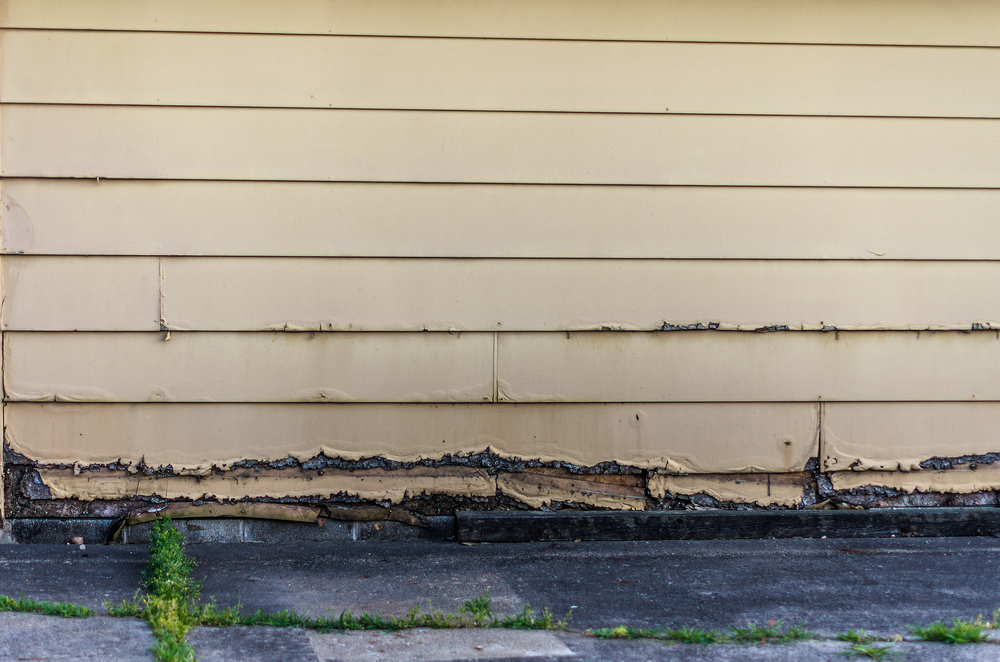The vast majority of new homes built today have gutters, and many owners of older homes opt to install gutters at some point to improve water collection and diversion away from the structure. However, fewer people have taken the time to invest in gutter guards. Installing gutter guards on your home helps prevent clogging by blocking leaves and other large debris from entering the gutters and creating clogs that stop water flow. Many homeowners might opt to install gutter guards because they’re tired of climbing up and down ladders to clean out their gutters manually. There’s another important reason to install gutter guards though: to prevent damage. Clogged gutters might not seem like a big deal, but once you read about these four costly types of damage, you might think twice about skipping gutter guards on your home.
1. Landscape Damage
Starting the list with the least costly type of damage, let’s focus on landscape damage. It might not seem significant to focus on sidewalks, patios, and flowerbeds, but the reality is that clogged gutters can lead to a lot of different types of peripheral damage to landscaping. When water cannot flow properly through your gutters, the first thing it is going to do is well up and overflow. This uncontrolled leaking of water often results in spills onto driveways, entry steps, patios, and landscape beds.
In the case of landscaping, in particular, the damage is largely visible. Mulch and dirt are moved around by the water and plants can be damaged. You’ve spent good money on your home’s curb appeal with that landscaping, and you’ll be spending it again if clogged gutters result in overflowing water that spills into flowerbeds and mulch.
There’s another damage that can result here as well. Consistent dripping and flowing water over the side of a gutter can shorten the length of your driveway by wearing away at it and creating pools of water on asphalt and paver-patio surfaces.
2. Fascia Board Damage
Most homes are constructed of wooden frames and have a finished siding over that frame. When gutters are installed, they are anchored into wood or aluminum fascia boards underneath your exterior siding. If you don’t have gutter guards, you could face a chain reaction that results in thousands of dollars in repairs. When water cannot flow through your gutters, most of it is retained in the gutter and adds extra weight to the gutter system. This, in turn, puts greater stress on the fascia boards keeping the gutters connected to the home. If you live in a cold-weather climate, that weight is increased by the constant freeze-thaw cycle of winter weather.
Wood fascia boards cost roughly $6 to $10 per linear foot to purchase, while aluminum fascia boards cost anywhere from $8 to $20 per linear foot. Add in the cost of a contractor to the complete the work, which ranges from $38 to $72 per hour, and you could pay anywhere from $800 to $6,000 to repair the fascia boards on your home. This depends, of course, on how much of your fascia board is damaged and needs replacing. Given the average gutter guard system costs just $1,500 to $2,000 to install, it could actually save you a lot of money in the long run.
3. Structural Damage
Believe it or not, clogged gutters can actually result in significant interior structural damage to your home as well. If you live in a cold-weather climate, clogged gutters can lead to a situation known as ice damming. This occurs during freeze-thaw cycles as snow melts. When that melting snow doesn’t drain properly through gutters, it backs up in the gutters and onto the roof. As sunny days recede into cold nights, that water backup freezes. This freeze-thaw pattern continues and puts stress on your roof. On top of that, it puts a large pool of trapped water on your roof that will look for anywhere it can to drain off.
In most cases, ice damming results in damage to the interior of homes. Water seeps through roofing and siding, penetrating interior walls and damaging wall structures, insulation, and drywall inside of the home. Depending on where the leak occurs, it could also result in damage to carpeted areas of the home.
4. Foundation Damage
Finally, the most expensive potential damage resulting from clogged gutters focuses on your foundation. The primary role of your gutters is to channel water away from the foundation of your home. Rather than letting it pool up against your home where the structure meets ground level, clean-flowing gutters rush water off the roof, channel it into downspouts, and discharge it safely away from your home toward a downward slope. When this doesn’t happen, and water pools near the foundation, the most common result is cracking in the foundation. The worst-case scenario, if left unchecked for a long period of time, is the failure of the foundation and collapse. Another possible outcome is mold growth within the foundation.
HomeAdvisor has a breakdown of the average costs to repair foundation damage. If you catch a problem when it is small, such as a minor crack, you’re likely to pay as little as $500. However, the average foundation repair issue costs $4,060, and if major repairs are required that call for hydraulic piers to stabilize the home, you’re looking at costs that could soar beyond $10,000.
Gutter guards don’t exist purely to make your weekends easier. Yes, it’s great to avoid climbing up and down ladders getting your hands dirty in the muck that collects in unprotected gutters. More importantly, gutter guards serve a vital purpose in protecting your home against these various types of costly damage that result from clogging and inefficient water flow.
